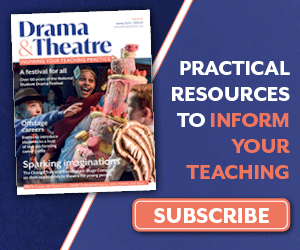Context for this Statement
A New Direction is a review of The Arts in Schools report marking the 40th anniversary of the Gulbenkian Foundation’s first publication. When The Arts in Schools report was published, it was extremely well received. Many local education authorities and their arts advisers adopted it as policy and conferences were organised for teachers, across the country, to engage in examples of good practice.
In an acknowledgement of the minimal references to Drama in both the original Report and in their own review Pauline Tambling and Sally Bacon, co-writers of the review, asked Geoff Readman to present National Drama’s ‘position’ concerning Drama in the curriculum during the last four decades.
The Drama Curriculum: forty years of ‘diminishing development’
Introduction
In the four decades since the Arts in School Report Drama and Theatre education, like other arts, has been at the centre of a multitude of reductionist educational and political priorities. National Drama (ND) regrets the fact that economic and party-political policies should be a reason for the marginalisation of children and young people’s experiences in developing imaginative thinking and creative learning. Although there have been times for optimism, in the main drama has been under-resourced and under-valued to such an extent that there is currently a risk of it becoming the sole preserve of the privileged and wealthy. Drama has not been marginalised in independent schools.
ND believes that all children and young people should have opportunities to learn about and through Drama and Theatre within a broad, balanced and coherent curriculum; a curriculum that is taught by teachers who have appropriate levels of subject knowledge and have received recent, relevant and high-quality training.
Drama is an art form in its own right. It warrants equal subject status to the other arts. The fact that it was misplaced within English simply indicates the view of the politicians who constructed the first NC Documents; it was a decision that has never been explained or adequately justified. English and Drama do share some common ground in relation to text, reading and oral work, but Drama reflects a far more complex identity than this. The current national curriculum of England, for KS1-3 does not contain any framework to ensure continuity and progression for learning in Drama or for development of drama skills.
Curriculum Identity
Drama is an essentially artistic, multi-faceted and practical subject with its own distinct concepts, knowledge, skills and forms. Its pedagogical qualities need to be celebrated as unique dimensions of the process and not, as is sometimes the case, used as a pejorative descriptor to undermine its curriculum status. To clarify this point; Drama can indeed be a powerful cross curricular learning medium, but it is only truly effective when such aesthetic elements as fictional role, narrative, audience, context, focus, tension, movement and language are present in the learning context.
The unhelpful distinction between ‘drama in education’ and ‘learning about theatre’ began with the highly influential publication of Development through Drama (1967) in which Brian Way claimed ‘there are two activities which should not be confused – one is theatre, the other is drama’ (1967:02). The historical consequences of this rift are still apparent. ND encourages an inclusive definition of all activities that facilitate learning through drama. Since Drama 5-16 (1989) there has rarely been an attempt to articulate a Drama curriculum for all children and young people of mandatory school age. A curriculum based upon a spectrum of learning that includes imaginative play in the early years and written plays performed in theatres. Perhaps now is the time to do so. The misunderstanding that continues to exist about the nature of Drama and Theatre needs to be urgently resolved by specialist practitioners themselves. Confusion over critical definitions continues to restrict meaningful dialogue.
The study of Theatre has, of course, an important contribution to make to a child’s ‘broad and balanced’ cultural education. ND encourages Theatre companies with Learning and Participation Departments to collaborate with schools in ways which both enrich and complement children’s learning. Schools and theatres should negotiate coherent, sustainable and relevant partnerships in which the discrete contribution of each is valued. However, participation in workshops or annual theatre visits cannot replace the benefits of drama teaching that ensures continuity and progression of learning in Drama. All children and young people are entitled to both professional theatre and to Drama as a curriculum subject in school time. Governments should not use the economy as a reason to deny them this right.
Drama’s contribution to children and young peoples’ education is social, communal, academic and artistic. It is ‘social’ in that it remains an essentially collaborative process, facilitating and exploring the development of personal self-esteem and wellbeing. It is ‘communal’ because it celebrates the values and ethos of the school; the Secondary Heads Association once claimed ‘a school without Drama is a school without a soul’ (1998). It is ‘academic’ because it develops skills in planning and generating ideas; imagining; negotiating; exploring; rehearsing; questioning; interpreting; researching; reflecting; problem-solving; presenting. It is ‘artistic’, because its artistic forms enable children and young people to both explore their World and also comment on the kind of World they wish to see.
The Coalition Government
In 2010, the so-called ‘reforms’ of the coalition government, plus the introduction of EBacc and STEM subjects had a devastating impact on Drama and Theatre education, in terms of funding and subject status. Indeed, arts education as a whole has been ‘progressively marginalised and devalued’ (Ashton and Ashton, 2022: 4). One ‘lost opportunity’ was the government’s rejection of Sir Jim Rose’s proposed primary national curriculum (2009). Rose’s proposals, at last, gave equal arts subject status to Drama, and made its teaching mandatory. Patrice Baldwin, then Chair of National Drama, was Rose’s Drama Editorial Expert.
However, there has been a more implicit, pervasive factor which has contributed to the current crisis in arts education. Learning has become knowledge-based and assessment driven. The vision of what is ‘learning excellence’ has been deliberately changed. Imposed curriculum constraints and summative assessment procedures have created a seismic shift in the culture of Drama teaching, learning values and artistic expectations. Education has become more functional, individually-orientated and assessment-driven. The identity of Drama as a subject has, out of necessity, been forced to change. Drama Departments, Examination Boards and Theatre Learning and Participation Departments have been compelled to radically re-appraise ‘what is possible’ in the current educational context which is characterised by constraints, results, accountability and market values.
The change in learning values, when combined with the impact of the pandemic and major funding cuts, has affected all phases of Drama and Theatre education: primary; secondary; special needs and alternative provision; theatres; universities; teacher education. The present government’s view of ‘effective teaching and learning’ reflects values that actually contradict established Drama and Theatre pedagogy.
The evidence to support ND’s argument can be found in statistics gathered by The Cultural Learning Alliance and the government itself (DfE, 2020):
- the number of drama teachers has been reduced by 18 per cent;
- the number of hours taught reduced by 12 per cent;
- examination entries in arts subjects reduced by 42 per cent.
In addition, there is an abundance of anecdotal evidence of schools discouraging students from taking GCSE Drama. In marked contrast to this rather ‘gloomy’ scenario, the growth in Drama and Theatre education for pupils in private education has been considerable. Independent schools continue to value Drama and many have invested heavily in theatre buildings and in professional partnerships with the industry (Ashton and Ashton, 2022).
National Drama is totally opposed to this inequality of provision and educational priority.
The current context for Drama in state schools
Primary Education
Whilst there remains excellent practice in some primary schools, the majority are finding it difficult to:
- Achieve more than the annual school production or Nativity Play;
- Provide subject-specialist CPD;
- Organise theatre visits or afford visiting artists;
- Find time to teach Drama and still meet all other requirements.
Secondary Education
- Teachers are pressured to achieve high results and thus feel compelled to design their curriculum around the syllabus requirements of one of the four Examination Boards, rather than the needs of young people.
- Subject options are sometimes made as early as Year 8, preventing opportunities for all students to a broad and balanced curriculum.
- The very identity of Drama and Theatre as a practical arts process is being undermined by the amount of written work. 70% at GCSE – 60% at A Level.
- The loss of educational Drama expertise nationally, due to retirement, redundancy and enforced stringency measures, has led to teachers relying on Theatre practitioners for CPD. This is creating an imbalance between Theatre and Drama processes.
Teacher Education
The proliferation of ‘school-based’ routes into teaching is resulting in a narrow and functional training experience. Learning how to teach Drama requires more than ‘subject knowledge’ and more than a restrictive focus on the existing practice of one or two schools:
- It needs well-resourced courses that are taught by experienced practitioners and include practical work that exemplifies key aspects of pedagogy and theory.
- It requires time for practical exploration, critical reflection and the assimilation of relevant research.
SEND Education
The marginalisation and neglect of the education of children and young people with particular learning needs must be addressed. There is an urgent need for:
- Drama CPD for teachers and support staff in SEND schools;
- Policies that clarify the role that theatre companies play in deepening learning for children and young people in SEND education;
- Funding for increased resources that develop classroom practice and theoretical understanding Drama in SEND schools.
A summary
Ultimately, the first published National Curriculum has resulted in:
- The formalisation of an arts hierarchy in which Drama, and Dance, are regularly at the bottom and misplaced within other subjects, i.e. English and PE respectively.
- Drama being an inappropriately placed dimension of the English curriculum. It has been progressively reduced to a descriptive paragraph and is focused on supporting the teaching of English rather than the teaching of Drama.
- Ofsted rarely reporting, in depth, on teaching and learning in Drama and not producing a subject report for Drama or even a Drama section within its recent subject research reports.
- Limited opportunities to attract funds for Drama research grants and teacher development.
- Theatre education becoming an expensive ‘curriculum extra’.
- The absence of mandatory requirements to include Drama in programmes of teacher training.
- Curriculum restrictions that have prevented the development of Drama pedagogy, endorsed by the closure of PGCE Drama specialist courses and the advent of school-based training.
- Drama Departments being undervalued. Many were viewed as easy targets when schools were being compelled to make cuts to focus on EBacc.
In conclusion
The learning benefits of Drama in school have not changed over the four decades. It continues to be a responsive and dynamic art form that enhances the education of all children and young people.
National Drama continues to celebrate all Drama and Theatre practices that facilitate learning, not simply those that are more easily assessed. Our desired curriculum includes theatre-making, imaginative and dramatic play, role-taking, rituals, digital and fictional narratives, social and communal game-playing, the practical interpretation and performance of written texts. These are all part of an artistic learning spectrum that develops creativity, personal, social, emotional and cultural knowledge through a collaborative and imagined learning experience. ND’s leading and informing priority is that children and young people’s academic, social and cultural needs should be placed at the centre of their learning.
Drama, as an art form, can be transformational for children, young people and their teachers. It is a process that explores what it is to be human in learning contexts that are relevant to local, national or global communities. Why then does it not receive the same curriculum recognition as other arts? Why is it only available to some children and not others?
Dr Geoff Readman
Chair National Drama
07/04/2023
References
Ashton, H and Ashton, D (2022) Creativity and the Curriculum: educational apartheid in 21st Century England, a European outlier. International Journal of Cultural Policy DOI:0.1080/10286632.2022.2058497.
Department of Education (1989) Drama 5-16 (Curriculum Matters:17). London: Her Majesty’s Stationery Office.
DfE (2020) School workforce in England 2021. https://explore-education-statistics.service.gov.uk/find-statistics/school-workforce-in-england
Secondary Heads Association (1998) DRAMA SETS YOU FREE. Bristol: Central Press.
Way, B. (1967) Development through Drama. London: Longman.




